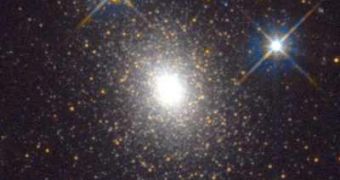New observations of a globular star cluster G1 - a large, bright ball of light in the center of the photograph consisting of at least 300,000 old stars - located in the Andromeda Galaxy (M31), show that it most probably has a midweight black hole at its center. This new find supports the theory that supermassive black holes at the cores of galaxies may have formed through mergers of smaller black holes.
Astronomers using the National Science Foundation's Very Large Array (VLA) radio telescope studied this cluster and think the black hole at its core is around 20,000 times more massive than the Sun.
James Ulvestad, of the National Radio Astronomy Observatory, Jenny Greene of Princeton University and Luis Ho of the Observatories of the Carnegie Institute of Washington, talked about their find: "That amount of mass is midway between the black holes left when giant stars explode as supernovae and the supermassive black holes with millions of times the mass of the Sun. It suggests that there is a clear path for forming the supermassive ones through successive mergers of smaller black holes."
So, it would seem that black holes can be associated with the formation of massive spherical bulges in galaxies and astronomers really found a direct link between the mass of the black hole in such a galaxy and the mass of its central bulge.
Still, no one can say for sure that every small galaxy in space has small black holes at the core, but the new discovery could provide new clues to the impact of black holes on galaxy formation. "In recent years, we have been detecting black holes with masses between 100,000 and a few million times the mass of the Sun, but less massive objects have been exceptionally difficult to find," said Greene.
Ho stated that "In 2005, we obtained better data that clinched the case that the cluster really does contain a dark object with 20,000 times the mass of the Sun. What we can't be sure of, however, is whether the dark mass is a single object --- that is, an intermediate-mass black hole --- or a cluster of smaller dark objects such as neutron stars or stellar-sized black holes."
"Since this globular cluster, G1, is by far the best candidate for containing such an intermediate-mass black hole, we felt it was important to help resolve the question," Ho added.

 14 DAY TRIAL //
14 DAY TRIAL //